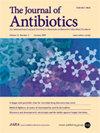Okichromanone,一种来自海洋的小孢子菌的新型抗病毒色满酮。
IF 2.1
4区 医学
Q3 BIOTECHNOLOGY & APPLIED MICROBIOLOGY
引用次数: 0
摘要
从海绵放线菌 Microbispora 的培养提取物中分离出了 Okichromanone(1)和已知的 1-hydroxyphenazine(2),这是一种新的色满酮。化合物 1 被证实是两种异构体结构(1a 和 1b)的混合物,比例接近 3:2。化合物 1 和 2 具有抗 HSV-I 的活性,IC50 值分别为 40 和 86 μM;具有抗 HSV-II 的活性,IC50 值分别为 59 和 123 μM。本文章由计算机程序翻译,如有差异,请以英文原文为准。


Okichromanone, a new antiviral chromanone from a marine-derived Microbispora
Okichromanone (1), a new chromanone, was isolated from the culture extract of a sponge-derived actinomycete Microbispora, along with known 1-hydroxyphenazine (2). Compound 1 was elucidated to exist as a mixture of two isomeric structures (1a and 1b) at a ratio of nearly 3:2. Compounds 1 and 2 showed anti HSV-I activity with IC50 values 40 and 86 μM, respectively, and anti HSV-II activity with IC50 values 59 and 123 μM, respectively.
求助全文
通过发布文献求助,成功后即可免费获取论文全文。
去求助
来源期刊

Journal of Antibiotics
医学-免疫学
CiteScore
6.60
自引率
3.00%
发文量
87
审稿时长
1 months
期刊介绍:
The Journal of Antibiotics seeks to promote research on antibiotics and related types of biologically active substances and publishes Articles, Review Articles, Brief Communication, Correspondence and other specially commissioned reports. The Journal of Antibiotics accepts papers on biochemical, chemical, microbiological and pharmacological studies. However, studies regarding human therapy do not fall under the journal’s scope. Contributions regarding recently discovered antibiotics and biologically active microbial products are particularly encouraged. Topics of particular interest within the journal''s scope include, but are not limited to, those listed below:
Discovery of new antibiotics and related types of biologically active substances
Production, isolation, characterization, structural elucidation, chemical synthesis and derivatization, biological activities, mechanisms of action, and structure-activity relationships of antibiotics and related types of biologically active substances
Biosynthesis, bioconversion, taxonomy and genetic studies on producing microorganisms, as well as improvement of production of antibiotics and related types of biologically active substances
Novel physical, chemical, biochemical, microbiological or pharmacological methods for detection, assay, determination, structural elucidation and evaluation of antibiotics and related types of biologically active substances
Newly found properties, mechanisms of action and resistance-development of antibiotics and related types of biologically active substances.
 求助内容:
求助内容: 应助结果提醒方式:
应助结果提醒方式:


